


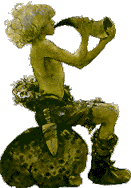
|
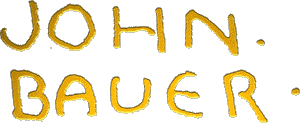 (This one's for Alice) |

|
Issue 2 features John Bauer artwork
Five pages of Bauer in #10 John Bauer was Swedish. Had he been English, we would be speaking of him in the same reverent breaths we use for Rackham and Nielsen. In fact, his influence on both of those, and other artists, is the subtext for this essay.
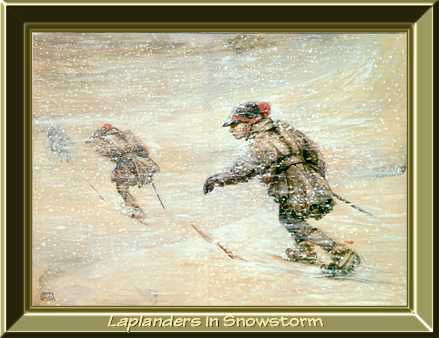
![]() Bauer was born on
June 4, 1882 (Rackham in 1867, Nielsen in 1886) in Jonkoping,
Sweden. At 16 he studied art in Stockholm and by 18 he was at
the Swedish Royal Academy. The prevailing styles of the day were
those of Anders Zorn and Carl Larsson - two great Swedish artistic
icons. Bauer strongly felt their influence, but also was swayed
by the surreal/fantasy work of Arnold Bocklin. While still a student,
he received his first major commission. It was a collection of
fairy tales by Anna Wahlenberg called Lange, Lange Sedan
(Long, Long Ago). After four years of study at the Academy,
he was commissioned to illustrate a book on Lapland.
Bauer was born on
June 4, 1882 (Rackham in 1867, Nielsen in 1886) in Jonkoping,
Sweden. At 16 he studied art in Stockholm and by 18 he was at
the Swedish Royal Academy. The prevailing styles of the day were
those of Anders Zorn and Carl Larsson - two great Swedish artistic
icons. Bauer strongly felt their influence, but also was swayed
by the surreal/fantasy work of Arnold Bocklin. While still a student,
he received his first major commission. It was a collection of
fairy tales by Anna Wahlenberg called Lange, Lange Sedan
(Long, Long Ago). After four years of study at the Academy,
he was commissioned to illustrate a book on Lapland.
Most of what I know about Bauer was gleaned from three books (see References) and they are all in Swedish - which I don't read. So a lot of what I say here may be prefixed by "I think." I apologize, but it's the best I can do.
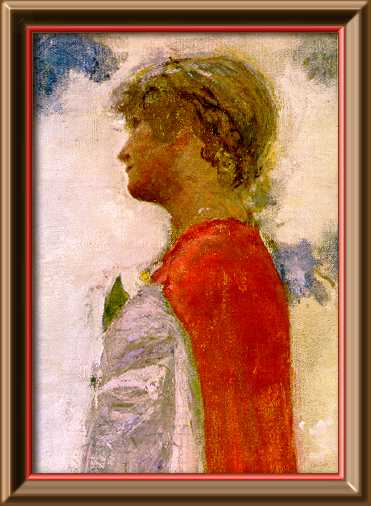 I think (see, I told you) that the image above
left is from that book on Lapland and that it was painted in 1904
or '05. The actual book, Lappland. Det stora svenska framtidslandet
(I think), was published in 1906. In 1904 he also painted a portrait
of his fellow art student, Ester Ellqvist (at right), and in 1906
he married her.
I think (see, I told you) that the image above
left is from that book on Lapland and that it was painted in 1904
or '05. The actual book, Lappland. Det stora svenska framtidslandet
(I think), was published in 1906. In 1904 he also painted a portrait
of his fellow art student, Ester Ellqvist (at right), and in 1906
he married her.
The following year Bauer began his association with Bland Tomtar och Troll (Among Elves and Trolls), an annual Christmas book for children. It was this work that made him famous in Sweden (and among artists elsewhere).
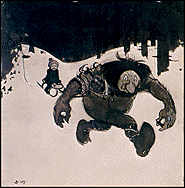 Bland Tomtar och Troll became a Swedish
tradition and Bauer's illustrations the benchmark for all other
artists (he was followed by Gustaf
Tenggren), but in 1907 it was a new, blank canvas that he'd
been hired to decorate. He filled that first issue with brave
knights rescuing young girls and young boys encountering trolls.
The elves weren't very evident. At left is one of the illustrations
from that first book. Note especially the abstract simplicity
of the "forest" in the background. (This image is taken
from the 1982 book John Bauer en Konstnar Och Hans Sagovarld
published in Stockholm by Bokforlaget Bra Bocker. The authors
of the book seem to have had access to the original Bauer paintings
and my scan picks up a great deal of the subtleties, but the tree
trunks can only barely be seen in the original and would not have
shown up in the printed version.) This simplicity and abstraction
wasn't present in all the images, but it presages the mature work
that was to follow.
Bland Tomtar och Troll became a Swedish
tradition and Bauer's illustrations the benchmark for all other
artists (he was followed by Gustaf
Tenggren), but in 1907 it was a new, blank canvas that he'd
been hired to decorate. He filled that first issue with brave
knights rescuing young girls and young boys encountering trolls.
The elves weren't very evident. At left is one of the illustrations
from that first book. Note especially the abstract simplicity
of the "forest" in the background. (This image is taken
from the 1982 book John Bauer en Konstnar Och Hans Sagovarld
published in Stockholm by Bokforlaget Bra Bocker. The authors
of the book seem to have had access to the original Bauer paintings
and my scan picks up a great deal of the subtleties, but the tree
trunks can only barely be seen in the original and would not have
shown up in the printed version.) This simplicity and abstraction
wasn't present in all the images, but it presages the mature work
that was to follow.
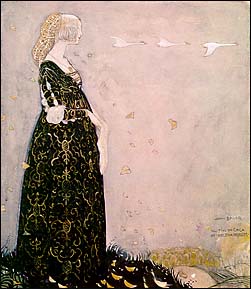 Bauer did the Bland Tomtar och Troll
annuals from 1907 to 1910. It was by no means his only work, but
I'm going to use these annual efforts to follow his stylistic
development. The illustration at left is from the 1908 book. It's
one of five illustrations for Helena Nyblom, Svanhamnen
(The Swan Suit). The composition is striking. The full profile
simplicity emphasizes the height of the hill upon which she stands.
The swans seem to emanate from her gaze and the falling leaves
remind us that she is anchored to the earth. The hint of a landscape
gives a further sense of height. The story revolves around a princess
who lost her swan suit - a cloak that transformed her into a swan.
She is shown here gazing wistfully at her sisters in the sky.
(Thanks to Mia Löwgren for the proper translation of the
title and for the story details.)
Bauer did the Bland Tomtar och Troll
annuals from 1907 to 1910. It was by no means his only work, but
I'm going to use these annual efforts to follow his stylistic
development. The illustration at left is from the 1908 book. It's
one of five illustrations for Helena Nyblom, Svanhamnen
(The Swan Suit). The composition is striking. The full profile
simplicity emphasizes the height of the hill upon which she stands.
The swans seem to emanate from her gaze and the falling leaves
remind us that she is anchored to the earth. The hint of a landscape
gives a further sense of height. The story revolves around a princess
who lost her swan suit - a cloak that transformed her into a swan.
She is shown here gazing wistfully at her sisters in the sky.
(Thanks to Mia Löwgren for the proper translation of the
title and for the story details.)
It's fairly apparent that he's still more at ease with classical illustration approaches, but his style has simplified and his ability to capture the essence of a story would serve him in good stead as he developed the synthesis of classicism and fantasy that would leave an indelible mark on fantastic illustration.
In 1908, he and Ester took a holiday to Germany and Italy,
gathering more artistic input for what was to be a brilliant,
but short career.

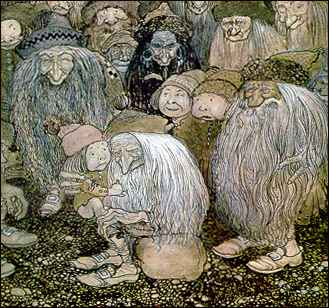
Somehow Bauer's trolls, no matter how twisted and ugly, weren't frightening. Even when they were performing dastardly deeds or were the size of a mountain, there were drawn with such gentle humor and with such sympathy that their features were still, well, pleasant. I think 1909 was the year that Bauer devoted his full artistic abilities to the depiction of these children's fantasies and, in doing so, raised the expectations of children and adults for children's literature.
Exactly the same thing was happening in England with the efforts of Arthur Rackham and Edmund Dulac. And there was a cross-fertilization of ideas and styles. The gnomes at right above owe a debt to the little men in Rackham's Rip Van Winkle, while several images from Rackham's The Rhinegold and The Valkyrie can be traced to elements and compositions right out of Bauer. Dulac and Kay Nielsen were also inspired by what was happening across the North Sea, Nielsen especially was fond of the profiled composition favored by Bauer.
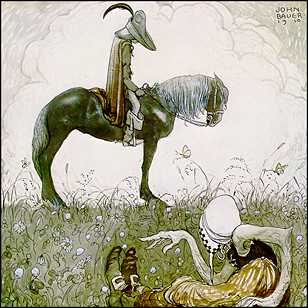

By 1910, the artist and the illustrator were perfectly fused and complemented by that uncanny ability to find the most pertinent moment and capture it; to augment the fairy tale with an insightful image. He skipped the 1911 annual and illustrated Fadernas Gudasaga and, I think, stories for other children's magazines. These other magazines only heightened his popularity and gained him more exposure. He illustrated works by nearly every famous Swedish storyteller. Many of these stories along with Bauer's Bland Tomtar och Troll illustrations appear in a lovely 1973 collection from Delacorte Press titled Great Swedish Fairy Tales.

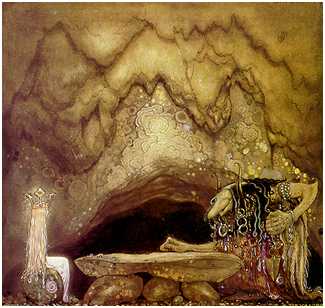
From 1912 through 1915, he returned to the annual Bland Tomtar och Troll with what was to become his most powerful and recognizable work. Each canvas was a stage and we, the audience for his performance, were transported to such forests and caves and glens as Bauer chose. His performers generally walked, rode, strode or ran across that stage in perfect profile but the simple, minimalistic, often stylized backgrounds set the performance solidly in a space and place that heightened the impact of the drama we were watching. You can tell that I've tried to analyze what he did that was so special, but I can't. I don't know why it works, it just does. It shouldn't. It's really much too basic, too simple to be so effective. Again and again, the same stage with different sets and actors is used to convey the whole spectrum of theatre, so why shouldn't it work for fantasy illustration? Well, the answer, is that of course it can. The question really is: with all the options opened to the illustrator that are seldom available to the playwright, why did Bauer set such arbitrary limits upon himself? We'll never know (well, unless someone has already figured it out and it just hasn't been translated into English yet).
At the age of 35, Bauer, Ester and their three year old son were drowned when a ferry they were taking to Jonkoping sank in Lake Vattern. Artists as gifted as Gustaf Tenggren and Brian Froud have paid homage to this incredible artist. Not much exists in English about Bauer.
 To learn more about John Bauer, visit the Jönköping's County Museum site or
see:
To learn more about John Bauer, visit the Jönköping's County Museum site or
see:| John Bauer Sagotecknaren | Harald Schiller, 1935 Sveriges Allmanna Konstforenings |
| Bauer en Konstnar and Hans Sagovarld | Per Bjurstrom, Gunnar Lindqvist, Agneta Bortz-Laine, Hans Holmberg, 1981 Nationalmuseum and Jonkopings lans Museum |
| John Bauer en Konstnar and Hans Sagovarld | Per Bjurstrom, Gunnar Lindqvist, Agneta Bortz-Laine, Hans Holmberg, 1982 Utgiven av Nationalmuseum and Bra Bocker, Hoganas |
| John Och Ester | Gunnar Lindqvist, 1991 Carlssons |
| The Vadeboncoeur Collection of Knowledge | Jim Vadeboncoeur, Jr. 1998 |
| The Vadeboncoeur Collection of ImageS 2, 10 | Jim Vadeboncoeur, Jr. 2001, 2008 JVJ Publishing |
|
This page written, designed & © 1998 by Jim Vadeboncoeur, Jr. Updated 2011. |
